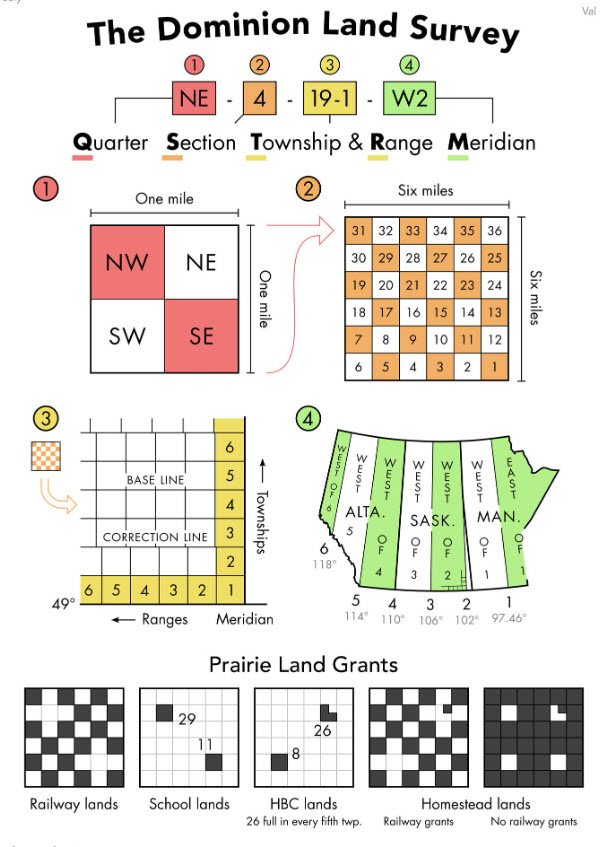by Martin Aarbo
The British North America Act on July 1, 1867, created the Dominion of Canada which extended only as far as the western boundary of Ontario. To the west and north-west lay a vast territory of land owned by the Hudson's Bay Co., known as Rupert's Land. It was not until 1869 that Canada purchased this land from the Hudson's Bay Co. for 300,000 pounds sterling and 7,000,000 acres of land. This purchase opened the land for settlement and in 1871 the Homestead Act was passed and the task of surveying was begun.
The surveyors selected a north-south line east of Winnipeg and for surveyors' purpose they called it the first meridian. The fourth meridian forms the eastern boundary of Alberta. The first row of townships running east and west along the international border is number one and rows are numbered in order from there north, 1, 2, 3, 4. The rows of townships running north and south are called ranges and are numbered from the meridian west. As any compass pointed about eighteen degrees east of north, of necessity the south to north survey lines were corrected every 24 miles, by moving them westward the necessary distance for complete adjustments. These are known as correction lines, always on township lines.

Each township is six miles square, containing 36 sections, each one mile square or 640 acres. Road allowances are 66 feet wide with north-south roads running between each section and east-west roads two miles apart.
Sections 11 and 29 are reserved for school land. The Hudson's Bay Co. was granted section 8 and three quarters of 26 in each township, the northeast quarter of 26 being home-stead land. In our area north of the North Saskatchewan River the Hudson's Bay Co. did not aquire this land. All even numbered sections were homestead land and all odd numbered sections were C.P.R. land. At the time of the construction of the C.P. Railroad, the Government of Canada granted this company tax-free 25 million acres of land in the west, to help finance a railroad through this virgin country.
It was in 1883 or 84 that Mr. C.A. Magrath D.T.S. was the first to start surveying the outlines of the townships in this area. With the help of T.W. Chalmers D.L.S., this part was completed on October 31, 1896. Then in 1903 and 1904 J.J. Dalton, J.B. Saint Cyr, T.S. Nash and M.W. Hopkins came to survey the townships into sections and quarters so that homesteading could begin. Each quarter contained 160 acres.
Surveyor's Chain: The unit of measurement in surveying is the Gunter's Chain consisting of 100 links each 7.92 inches long, a total of 66 feet. This explains why so many rural roads are 66 feet wide. A steel band is now more used than the chain, as it is easier to manipulate.
Surveying in this area was much more difficult than the southern prairies. Cut lines had to be cut 8 to 12 feet wide through heavy bush to avoid interference with the surveyors instruments. The rivers, lakes, muskegs and creeks all became hazards, not to mention the black flies and mosquitoes that at certain seasons made the workers' living conditions unbearable.
The sections were numbered with Roman numerals on round iron stakes, three feet long with six inches of top squared for numbering of the sections. These stakes were driven into the ground at the north-east corner of each section. At half mile intervals, both from south to north and east to west on section lines, the surveyors dug four holes about eight feet apart and two feet square to a depth of about sixteen inches. Here a dirt mound was made with a wooden stake driven in the exact location with the numeral 1/4 cut into the stake near the top.
After 1905, up until about 1920, surveyors came to do the topographical surveys, which are on a much more extended scale. This was done for the purpose of producing maps that will show elevations and depressions of land, the locations of bodies of water and other features.
In the spring of 1910, surveyors were active surveying wagon roads. The government sternwheeler survey yacht plying the river from Edmonton to Winnipeg passed here June 20, 1910, stopping to leave supplies to government surveyors working in this area.



